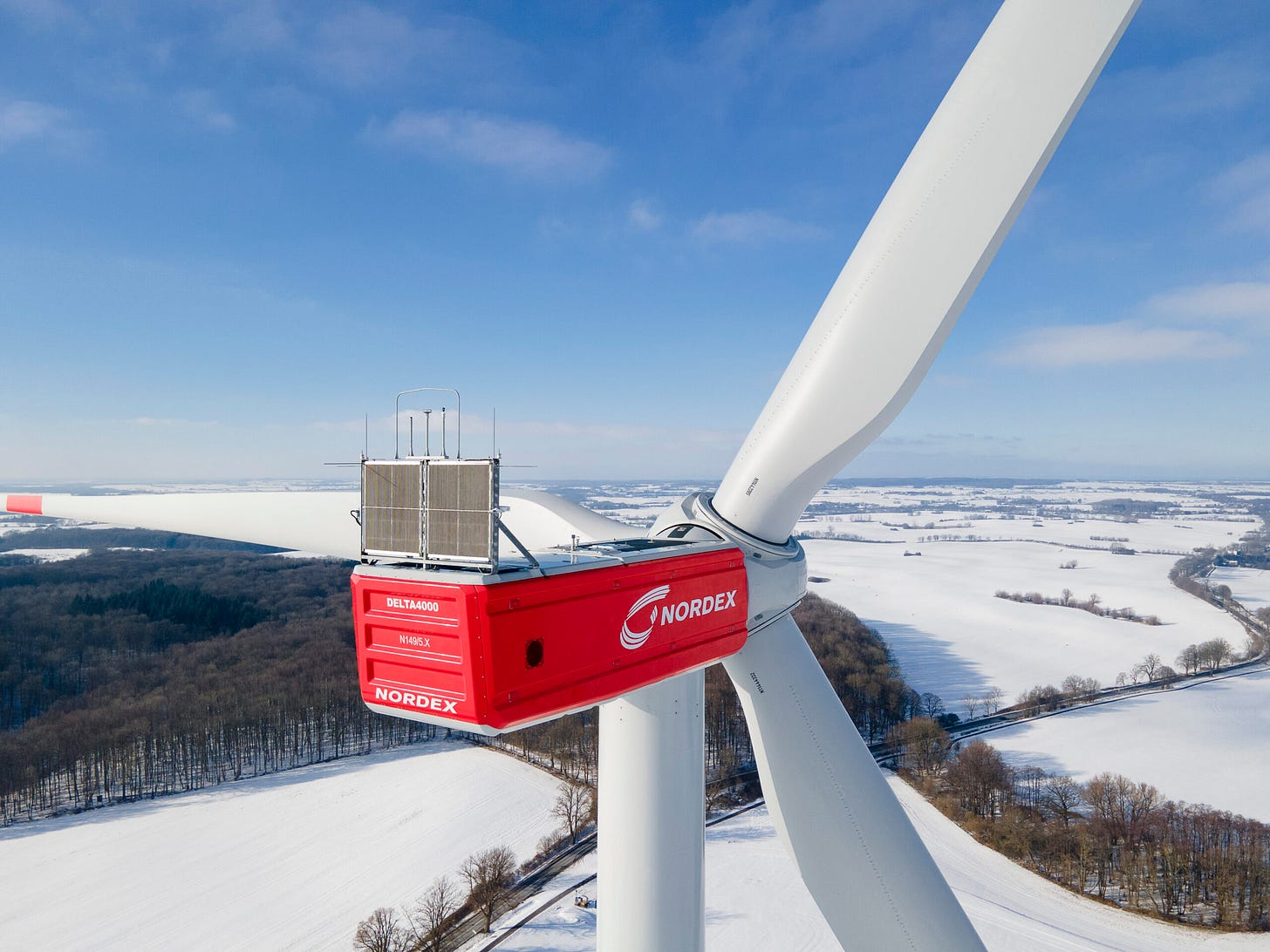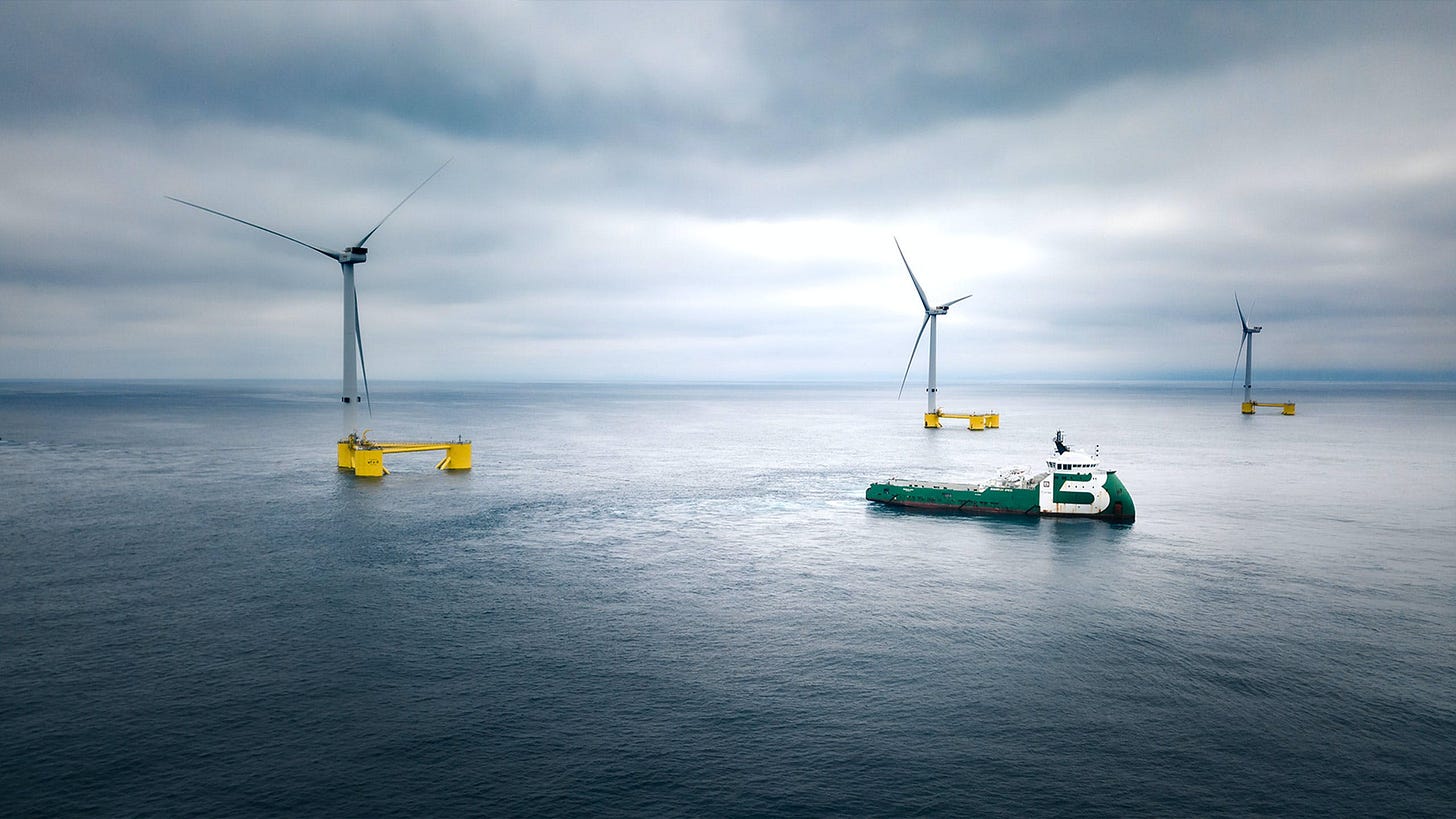Windletter #69 - First green shoots for Western wind turbine manufacturers
Also: WindFloat Atlantic exceeds all predictions, what's happening with offshore in the US, the expansion of Østerild Test Centre, and more.
Hello everyone and welcome to a new issue of Windletter. I'm Sergio Fernández Munguía (@Sergio_FerMun) and here we discuss the latest news in the wind power sector from a different perspective. If you enjoy the newsletter and are not subscribed, you can do so here.
The most read from the last edition has been: visualizing the data of the construction of Dogger Bank A, the trucks transporting blades blocked on Spanish roads, and the tensioned Vestas rotor.
Now, as dictated by the standards, let's move on to the news of the week.
Vestas shows the way back to profitability while Nordex ties
Back to black. Good news for the sector and for Western manufacturers in particular, who are beginning to see light at the end of the tunnel. After some years of journey, Vestas has managed to return to profitability in the results of the year 2023, while Nordex has practically remained at a tie.
Let's start with Vestas. These have been their highlights:
Return to profitability with an EBIT of 1.5%. As a result, Vestas will pay bonuses to its employees for the first time in 4 years.
Record orders with 18.4 GW thanks to significant growth in onshore and offshore.
Revenues of 15,400 million euros due to price increases and growth in the services division.
Furthermore, Vestas commits to maintaining commercial discipline by prioritizing value over volume, while expecting revenues between 16,000 and 18,000 million euros in 2024 and an EBIT of 4-6%.
Here are the links to the reports for those who want more detail:
Investor Presentation (pdf). Summary of the main data and figures.
Annual Report 2023 (pdf). Complete report.
Nordex, on the other hand, has announced its preliminary results, of which we can highlight:
Tie in profitability with an EBIT of 0% (2 million euros).
Record orders with 7.4 GW.
Revenues of 6,500 millions, even above the most optimistic forecast.
Financial reports presentations are not yet published, only this press release.
Regarding Siemens Gamesa and General Electric's wind business, analyzing the results is a bit more complicated since they are diluted within their respective parent companies. However, in the case of GE, it will soon spin off GE Vernova, which will encompass the renewable and electrical networks business.
In the case of Siemens Gamesa, the latest available results are from Q1 of FY24 (the fiscal year does not align with the calendar year), but in any case, the picture is very different. They continue to face issues with the onshore 4.X and 5.X platforms, and the company is focused on resolving them, even having halted sales.
Here are the links to Siemens Energy's presentations and reports:
As for GE, it can be interpreted as a mixed bag. The onshore business is profitable, while offshore seems to still have issues with Haliade X deliveries.
Here are the links to General Electric's presentations and reports:
_
Envision secures its first order in the Philippines
Chinese manufacturers continue to work on their international expansion. This time, it's the turn of the Philippines, where Envision has announced that it has won its first contract.
The contract involves 162 MW for the Alabat and Tanay wind farms of the developer Alternergy. The wind turbines consist of a combination of 6.5 MW and 8 MW models. Additionally, the contract also includes 10 years of maintenance.
Envision is not the first Chinese manufacturer to enter the country, as Goldwind signed a 132 MW contract back in 2017.
_
WindFloat Atlantic exceeds all predictions
WindFloat Atlantic, a floating wind farm located off the coast of Portugal, celebrates 4 years with excellent production figures. The park is owned by Ocean Winds, Repsol, and Principle Power, with Ocean Winds (Engie and EDPR) as the largest shareholder with 85.17% ownership.
It consists of 3 Vestas V164-8.4 MW wind turbines located in the Portuguese municipality of Viana do Castelo, very close to Galicia.
According to Principle Power, the wind farm generated 80 GWh of energy last year, translating into 3,200 equivalent hours and a capacity factor of 36.5%. It may not seem like much, but it represents a significant improvement over the capacity factor of the first 3 years, which, according to calculations in Windletter #22, was 19.6% (1,700 equivalent hours).
Although the data from the first years may not be representative, as these wind turbines likely had many stops for tests, inspections, controls, etc. After all, it is a pilot project. In fact, we know that the wind turbines had to be towed to port for corrective maintenance.
What about offshore in the USA?
Great analysis by Kiko Maza on the situation of offshore wind in the United States following various announcements of cancellations, delays, and renegotiations of PPAs in several projects.
Here's an excerpt from the article, and you can read the rest in the link below:
Large projects canceled, developers facing financial challenges, supply chains seeing their investments at risk, regulators struggling to incentivize the business... it seems that over the past year, all news related to offshore wind in the USA has been negative. How serious is the situation? What are the causes? Today, we dive into the turbulent waters of offshore wind in the USA.
Østerild could be expanded to test wind turbines up to 450 meters tall
The Østerild Test Centre is arguably the most important wind turbine testing center in the world. Dozens of models from leading manufacturers worldwide (especially Western ones) have been tested there and continue to be tested. The center is managed by the Technical University of Denmark (DTU).
Opened in 2012, it's likely that in the early days, no one anticipated the size that wind turbines would reach today. Currently, the largest machines installed there are the Siemens Gamesa SG14.0-236 and the Vestas V236-15 MW, with blade tip heights of 278 and 280 meters respectively.
However, wind turbines continue to grow, and the need for testing, trials, and certifications is becoming increasingly important in an industry that seeks to minimize risks and increase turbine reliability.
Therefore, in anticipation of future wind turbines, the parliament has already initiated the necessary procedures to carry out an expansion located north of the current site.
The expansion would consist of 3 new positions added to the existing 9. Two of these positions would be prepared for wind turbines with blade tip heights of up to 450 meters, anticipating the future giants.
However, this expansion should not be related to the prototype of the world's most powerful offshore wind turbine that Siemens Gamesa is expected to install soon in one of the current locations.
_
Pipeline of onshore projects in the permitting phase in the top 5 European markets
An interesting graph shared by Cristian Bogdan Dinca on LinkedIn shows the megawatt capacity of the top 5 onshore markets in Europe.
In the post, Cristian analyzes the different challenges each country faces. The cases of Italy and Germany are particularly striking, demonstrating that having a large or small pipeline does not necessarily mean it's good or bad.
_
The curious Super Compact Drivetrain nacelle by Mingyang
The curiosity of this edition comes from Mingyang and its peculiar nacelle with a super-compact drivetrain.
While browsing LinkedIn, I came across the following video, which provides a closer look at some details of this nacelle. As one of you mentioned to me.
The SCD (Super Compact Drivetrain) solution looks promising on paper because it is a compact and lightweight nacelle. However, it also has its disadvantages. For example, if you encounter problems with the main bearing in the field, you have to dismantle the rotor and transport the entire drivetrain to port for repair or replacement.
For those who want to learn more about this design, here is a presentation from Aerodyn, the German company that designed it and licensed it to Mingyang.
Thank you very much for reading Windletter. If you enjoyed it, I invite you to subscribe, leave a ❤️, forward it by email, share it on social media, or recommend it to others.
You can follow Windletter's profiles on Twitter and LinkedIn. Also, if you enjoy reading about energy, check out Windletter's Library.
You can also contact me through my Twitter or LinkedIn profiles.
See you in the next one!
And if you feel like it, recommend Windletter to help me grow 🚀
Disclaimer: The opinions presented in Windletter are mine and do not necessarily reflect the views of my employer.










